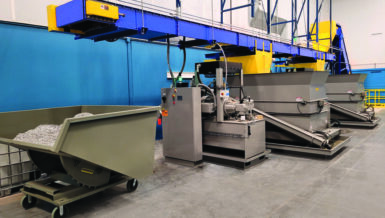There are several factors to consider when choosing the right model for your needs:
- Desired production rates
- Machine design
- Customization
- Support from the manufacturer and dealer
According to Duwayne Bonhorst, product specialist at Vermeer, production rates can be affected by machine design. “Trommel screens are engineered to size material,” he explained. “Smaller material (fines) falls through the screen, while larger material (overs) gets pushed out the back. Along with facility location and the type of material being processed, the machine design is just as important as its size when it comes to swapping out screens or drums and performing routine maintenance.”
Production rates
To begin choosing the right size trommel screen for your operation, Bonhorst recommends looking at the screen size. “Most operations are looking for screens between a 1/8 inch to 3 inches (.3 cm to 7.6 cm), and production rates can vary greatly depending on size selected,” he said. “Smaller screens produce more fine material for reselling. A company that is producing soil will have substantially more overs than if they are producing mulch and require a lot more material to be run through the screen to amass the same volume of material.”
The length of the drum on the trommel screen is another important consideration for production rates. Longer drum lengths give the material more time to separate fines from overs.
Machine design
Thinking about where your trommel screen will be working is also essential for selecting the right model. Some models will have conveyers off to the side while others are designed with conveyers only off the front and back. “Space becomes a factor for companies with smaller yards, which is pretty common when working in an urban environment,” Bonhorst explains. “For these locations, a trommel screen with a conveyer out to the side, like the Vermeer TR6400 trommel screen, may be a better fit. For similar production rates on larger, more open yards, the Vermeer TR626 trommel screen should also be considered.”
Other machine design considerations include the hopper dump height, operator controls and ease of serviceability.
“Hopper height and size along with the ability to adjust as needed, are crucial to how efficiently a trommel screen will run,” explained Bonhorst. “The size of the hopper dictates how much material can be added at a time, but the hopper’s height will impact cycle times, setup time and spillage when adding material.” When working with lower hopper heights, like those found on Vermeer trommel screens, operators aren’t having to raise their buckets as high. This can help keep cycle times short as well as reduce the chance of materials spilling. With a lower hopper height, the ramp to feed the machine does not have to be built, which can also save time during site setup.
Next, you need to consider how to make performance adjustments to the trommel screen. Vermeer trommel screens feature the Vermeer DP10 display, which allows operators to make adjustments from a control panel on the side or from a handheld transceiver remote that can be used in the cab of a wheel loader.
According to Bonhorst, you should also think about serviceability. “We’ve designed Vermeer trommel screens to give operators and service technicians full-length access to the drum, making it possible to perform routine service work from the ground level,” he explained.
Customization
It is important for your trommel screen to have the ability to be customized for any unique needs you have based on things like local regulations or material types. For example, some cities may have strict dust regulations, so you may need to add a dust cover to help keep dust levels down. Or if you’re working with wet material a lot, an extra set of brushes can help reduce the amount of time you spend cleaning screens. If you’re working with a Vermeer dealer, they can help you understand what optional accessories are available for a particular trommel screen and get you set up with what you need.
Support
Finally, when you’re shopping for a trommel screen, who you choose to do business with matters a lot. A trommel screen is likely not the only piece of equipment in your fleet. So, it’s crucial to select a dealer and manufacturer who understand your industry and can help you operate as efficiently as possible through every step of your production process. Vermeer and your local Vermeer Recycling and Forestry specialist can answer any questions you may have when choosing a trommel screen or any other related matters. They can also help you dial in your operation and help with any of your service needs.






















